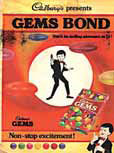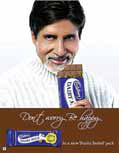Issue No.19 / December 1-15,2015

If it’s a chocolate, it has to be a Cadbury. Here’s the lowdown on India’s never-ending love affair with the chocolate brand that has traversed boundaries of strata, age and occasion. You just need a reason or none at all to sink your teeth into its velvety depths
For a nation that has a staggering range of delicious homemade, indigenous mithais rooted in its history and cultural ethos, it’s no mean feat for a chocolate brand (perceived as a phoren import) to win hearts across age and socio-cultural boundaries. But then, chocolate is chocolate is a Cadbury !! And India won’t have it any other way
With a whopping 55.5 percent share of India’s Rs.10,000 crore chocolate market, Mondelez India, formerly Cadbury India, is a show-stopper all the way.
Young or old, everyone has a favourite tale to narrate about their favourite Dairy Milk or Five Star.
There’s hardly a child that doesn’t remember their first traumatic day in nursery being sweetened with a packet of Gems, a teenager that has not consumed an entire box with milk all the better to deal with exam nerves, or a young woman who has been not been wooed with a range of Dairy Milks by a besotted suitor.
Like their ad campaign will have you know, there’s a Cadbury for every season and reason. Go on, savour the taste.
To sum up a long journey in short, Cadbury is a British MNC owned by Mondelez International, specialising in confectionery. It is the second largest brand in the segment, right behind Wrigley’s. With its head office in Uxbridge, London, it has operations in over 50 countries worldwide.
Established in 1824 in Birmingham by John Cadbury, a merchant who sold tea, coffee and drinking chocolate, and who foresaw the potential of making it into a mass product the business went from strength. Gradually, his brother Benjamin and sons Richard and George joined hands too.
But the companies most popular product ever the Dairy Milk Chocolate found takers from the time of its introduction in 1905. By 1914, the product was a resounding hit, and the rest, as they say is history.
In 1919, Cadbury merged with JS Fry &Sons and Schweppes in 1969. The company was bought by Kraft Foods in 2010. On 4 August 2011, Kraft Foods announced they would be splitting into two companies beginning on October 1, 2012.
Kraft’s confectionary business became Mondelez International with Cadbury as a subsidiary. Chocolate confectionary, biscuits, beverages, gum and candy are the different categories the company operates in.
Sure enough, if one were to look carefully behind the wrapper, you will find the name Mondelez!
On the Other hand, the hysterical ‘Pappu Paas Ho Gaya’ campaign launched in 2005 which had Amitabh Bachchan acting as a shopkeeper, raked in the applause for sheer
PCadbury India made its debut on Indian shores in 1948. It has five manufacturing units all over India, namely at, Induri and Thane (Maharashtra), Bengaluru (Karnataka), Malanpur (Madhya Pradesh) and Baddi (Himachal.) Besides this, it has a cocoa operations office at Dharapuram in Tamil Nadu.
Cadbury has also played a leading role in the milestones achieved in the hitherto unknown aspects of cocoa cultivation in India since 1965. Teams from Cadbury also conduct training workshops for cocoa farmers on the latest techniques and tools of increasing productivity. The research has been carried out with the help of Kerala Agricultural University

Take for instance the timing of the Real Taste of Life campaign. Just before this series was kickstarted, the chocolate industry was going through a rough patch. The price of cocoa had risen steeply in the 90s and the excised upped from 16 per cent to 27. The company had no choice but to increase the price of the chocolate. Also, chocolate back then was seen as a mere kiddie product. But the Real Taste of Life campaign showed Indians across all age groups that it was utterly cool to eat a Cadbury.
The iconic series, which memorably have a bubbly young woman spontaneously performing a jig on the cricket pitch to celebrate her boyfriend’s century, and a pregnant woman demanding a Cadbury from her husband as the baby in her womb demanded it too, won hearts and brought forth spontaneous laughter and tears. This campaign went on to win hosannas as ‘The Campaign of the Century’ in India at the Abby Awards.
On the other hand, the hysterical Pappu Paas Ho Gaya campaign launched in 2005 which had Amitabh Bachchan acting as a shopkeeper, raked in the applause for sheer comic value. Th e ad showed everyone on campus celebrating the much-awaited passing of Pappu, a rather slow but lovable young man by eating Cadbury.
This ad brought home the points that it was absolutely ok to eat a Cadbury, in this ad, funny man Cyrus Broacha is shown selling Cadbury’s Dairy Milk chocolate on the street, even as people are giving various whacky reasons for why they eat Cadbury
This was a much more broad-based attempt to increase the number of occasions on which people could treat themselves to a Dairy Milk and gradually replace traditional Mithai with Dairy Milk on all festive occasions. A particularly adorable ad under this campaign was the attempt to reach out to rural audiences with the hilarious Jab Radha Miss Palampur Bani. Th e ad showcased the celebrations of Radha the cow winning a beauty pageant by eating Cadbury.
Cadbury is a British MNC owned by Mondelez International, specialising in confectionery. It is the second largest brand in the segment-right behind Wrigley’s. With its head office in Uxbridge, London, it has operations in over 50 countries worldwide

Five Star: Launched in 1969, the chocolate is a winsome mix of chewy and velvety chocolate. The second largest brand aft er the Dairy Milk, its variants like 5 Star Crunchy and 5 Star Fruit and Nut are much loved too.
The Celebrations range: These boxes of chocolates contain assorted chocolates, or chocolate covered almonds and nuts, and
positioned to replace conventional gift items like boxes of malai burfi and ladoos on festivals like Diwali and Rakhi. The latest ad, for instance, shows the playful camaraderie between brother and sister, with the sister telling the brother that while she can protect herself, she realises he saved up his pocket money to buy her Cadbury Celebrations.
When the brother lunges for a taste of the chocolate, she pertly tells him that she is quite capable of looking aft er both herself and her chocolates!
Perk: The wafer cover chocolate launched in 1996 also famously marks the debut of the effervescent model-actor Preity Zinta who is leading a students’ hunger strike, but eating Perk on the sly. The ad, endearingly cheeky and youthful, took both Zinta and Perk straight into the hall of hame. It also has other variants like Perk XL and Perk XXL.
Eclairs: The Cadbury Dairy Milk Eclairs is one of the most popular brands in the Eclairs category. The newly launched brand in this category is the Cadbury Eclairs Rich Brownie
Silk and Bubbly:The latest uber luxe chocolates to hit the market have the ads playing on the velvety and lush textures of the chocolate through irresistible photography and music.
Thus, we find that constant reinvention and a deep understanding of India’s cultural ethos has played a huge role in the product’s enduring success.
By Kalyani Sardesai